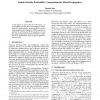NIPS
2004
14 years 4 months ago
2004
We describe how we used a data set of chorale harmonisations composed by Johann Sebastian Bach to train Hidden Markov Models. Using a probabilistic framework allows us to create a...
NAACL
2004
14 years 4 months ago
2004
We consider the problem of modeling the content structure of texts within a specific domain, in terms of the topics the texts address and the order in which these topics appear. W...
IJCAI
2001
14 years 4 months ago
2001
We study the application of Hidden Markov Models (HMMs) to learning information extractors for
IWEC
2004
14 years 4 months ago
2004
In this paper, we describe our work on classification of players in Massively Multiplayer Online Games using Hidden Markov Models based on player action sequences. In our previous ...
FLAIRS
2006
14 years 4 months ago
2006
Hidden Markov models play a critical role in the modelling and problem solving of important AI tasks such as speech recognition and natural language processing. However, the stude...
AAAI
2004
14 years 4 months ago
2004
Repetition is an important phenomenon in a variety of domains, such as music, computer programs and architectural drawings. A generative model for these domains should account for...
NIPS
2007
14 years 4 months ago
2007
We investigate a family of inference problems on Markov models, where many sample paths are drawn from a Markov chain and partial information is revealed to an observer who attemp...
NIPS
2008
14 years 4 months ago
2008
Neural activity is non-stationary and varies across time. Hidden Markov Models (HMMs) have been used to track the state transition among quasi-stationary discrete neural states. W...
IJCAI
2007
14 years 4 months ago
2007
In this paper we prove that the well-known correspondence between the forward-backward algorithm for hidden Markov models (HMMs) and belief propagation (BP) applied to HMMs can be...
IJCAI
2007
14 years 4 months ago
2007
This paper presents an algorithm for inferring a Structured Hidden Markov Model (S-HMM) from a set of sequences. The S-HMMs are a sub-class of the Hierarchical Hidden Markov Model...



